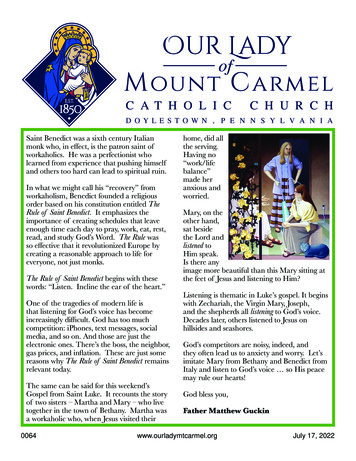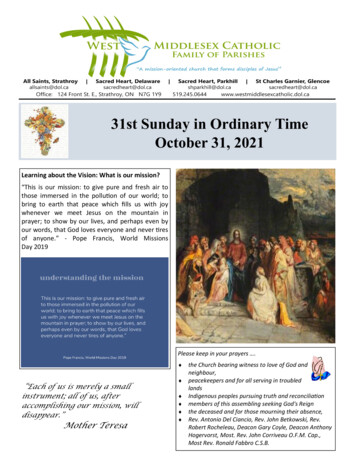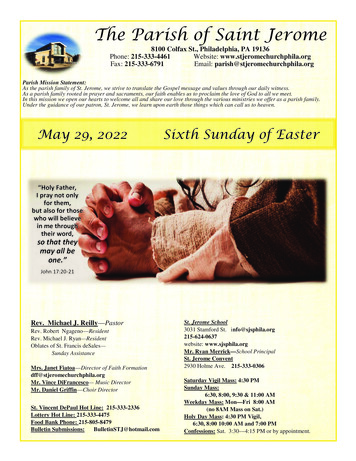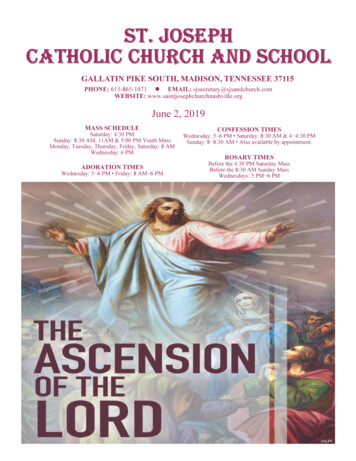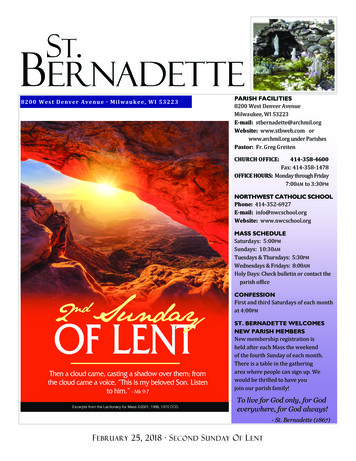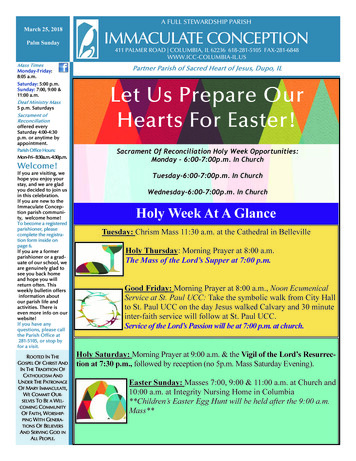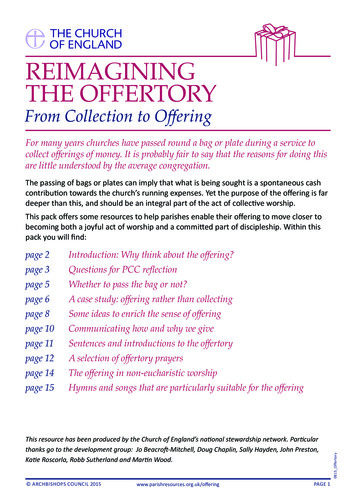
Transcription
REIMAGININGTHE OFFERTORYFrom Collection to OfferingFor many years churches have passed round a bag or plate during a service tocollect offerings of money. It is probably fair to say that the reasons for doing thisare little understood by the average congregation.The passing of bags or plates can imply that what is being sought is a spontaneous cashcontribution towards the church’s running expenses. Yet the purpose of the offering is fardeeper than this, and should be an integral part of the act of collective worship.This pack offers some resources to help parishes enable their offering to move closer tobecoming both a joyful act of worship and a committed part of discipleship. Within thispack you will find:page 2Introduction: Why think about the offering?page 5Whether to pass the bag or not?page 6page 8page 10page 11page 12page 14page 15Questions for PCC reflectionA case study: offering rather than collectingSome ideas to enrich the sense of offeringCommunicating how and why we giveSentences and introductions to the offertoryA selection of offertory prayersThe offering in non-eucharistic worshipHymns and songs that are particularly suitable for the offeringThis resource has been produced by the Church of England’s national stewardship network. Particularthanks go to the development group: Jo Beacroft-Mitchell, Doug Chaplin, Sally Hayden, John Preston,Katie Roscorla, Robb Sutherland and Martin Wood. Archbishops Council 2015www.parishresources.org.uk/offeringPage 10815 Offertorypage 3
REIMAGINING THE OFFERTORY : Introduction: Why think about the offering?Why think about the offertory?Throughout scripture the practice of givingcombines the practical resourcing of priestlyministry and the work of the church with the actof making an offering back to God which expressesour thanks for his rich generosity to us. Giving hasalways formed a part of worship. It could hardlybe otherwise for God made us body and soul. Butin practice, many churches have thought littleabout why we have an act of giving as part of ourworship.From the earliest times, the offering of sacrificesand the burning of expensive incense enabledthe giving of an offering to be a part of worship.The law of the first fruits in Deuteronomy 26:111 is an act of thanksgiving for God’s provisionand act of proclamation as those for whom theland is God’s gift tell the story of the rescue fromEgypt. In Numbers 18:21-32 the tithe sustains theLevites, and the passage establishes a principle, ifnot a definitive pattern, of financial support forlocal church leadership which in 1 Corinthians 9becomes the key principle that those who sharethe gospel get their living from the gospel (1 Cor9:7-12). And, of course, King David’s great prayerof thanksgiving as material gifts are given tobuild the first Temple is echoed in churches everySunday as the financial gifts of God’s people arereceived (1 Chronicles 29:10-20)Almsgiving has long been linked to the offering.The earliest version of the Book of Common Prayerin 1547, “In the meane time, whyles the Clerkesdo syng the Offertory, so many as are disposed,shall offer unto the poore mennes boxe every oneaccordynge to his habilitie and charitable mynde.”Historically the church appointed a deacon as akind of ‘social security fund’ officer sharing whatwas collected according to need.Giving expresses our love for God, and respondsto God’s generosity to us. Such grace not onlycreates a beautiful world for us to inhabit, providesgenerously for our daily needs and enables usto love and be loved. Supremely in Jesus’ selfoffering, we have the way to be reconciled withthe Father and to enter into an eternal relationshipwith him.Since “where our treasure is, there our heartis also”, the offering of money provides aunique proxy for offering ourselves back to agenerous God. All of these rich themes feed intothe offertory as the most visible and tangibleexpression of our giving as Christian people,and our offertory practice should reflect this.0815 OffertoryActs describes the early church giving to sharein a communal life. Those who had used whatthey had to meet the needs of others. Paul writesin 2 Corinthians 8 and 9 of a collection for thepoor and of the interplay of financial and spiritualblessing and elsewhere of churches sharing theirgifts and skills as well as food and money. Giving inthe context of worship reflects the importance ofgiving in community. Archbishops Council 2015www.parishresources.org.uk/offeringPage 2
REIMAGINING THE OFFERTORY : Questions for PCC ReflectionQuestions for PCC ReflectionThese questions are here to help you think through your church’s practice in relation to the offering ofmoney. It’s not just about “how much is received” but also about how we enable church members tomake an offering of money as a proxy for offering themselves in the context of worship, and whether weenable people to give at realistic levels, joyfully and with thanksgiving.1What does your giving mean to you in the context of worship? (tick all that apply)a)It’s my contribution to the work of the churchb)It’s a scrabble to find some cash that interrupts my worshipc)It represents the giving of myself to Godd)It’s a way to say thank you to Gode)It makes me feel like I’m part of a communityf)I’ve never really thought about itg)Something else1Giving is far more than collecting funds for the church’s mission and ministry. It can provide anopportunity to offer ourselves, individual and communally, in the context of worship, with moneyrepresenting all that we stand for – our values and priorities.2Which of these practices applies to your church? (again, tick all that apply)We pass around a bag/plate during the serviceWe tend to use the same offertory prayerA bag or plate or box is available at the backWe sing a hymn whilst this happensOur service sheet explains what we are doing and whyWe have tokens for regular giversThe bag or plate is brought to the front during the serviceThe offering is announced from the front, and we explain its purpose1It always happens at the same time during the serviceWe occasionally do something different that makes us think Archbishops Council 2015www.parishresources.org.uk/offering0815 OffertoryMany churches have not thought about their practice in relation to the offering and have simplycontinued practice that may have been established years ago. This exercise provides you a chanceto think about what you are doing and why.Page 3
REIMAGINING THE OFFERTORY : Questions for PCC Reflection3As you think about your church’s practice, in what ways does it help,and in what ways does it hinder, a sense of offering in the context of worship?Things that helpHow or why do they help?Things that hinderHow or why do they hinder?4If a visitor came to your church, what would they understand the collection/offering to be about? Why would they think that?5What do you think are the arguments for and against passing a bag orplate in church?For6AgainstHow might you change your current practice to enrich it? Archbishops Council 2015www.parishresources.org.uk/offering0815 OffertoryThis resource pack provides materials to help parishes think through their practice in relation to theoffering. You will find material to help you consider whether to pass a bag or plate around during aservice, different offertory prayers, ideas for doing it differently for a change, and much more.It can be found at www.parishresources.org.uk/offeringPage 4
REIMAGINING THE OFFERTORY : Whether or not to pass a bag or plate Whether or not to pass a bag or plate Offertory collections developed in the days when people were paid weekly in notes and coins. These daysmost people’s income comes through bank accounts, including pensions and social security benefits.For many people, it is easier to give by bank standing order, as it saves finding the right change each week.It also helps people gradually to increase their regular giving from year to year in line with inflation,without having to find odd amounts of cash every week. Switching to direct debits or standing orders: improves the regularity and consistency of church income cuts the volunteer time needed to open and check the envelopes after the service minimises the risks involved in weekly cash banking cuts stationery costs - dated envelope sets are fairly expensive helps the church to budget and manage its finances more effectively, and bank statements provide an independent audit trail for the Inland Revenue.However, there is something very significant about money representing us – what we do with ourmoney defines us and our priorities. The offering of money within the context of worship providesan opportunity for a symbolic offering of ourselves and our resources. The National StewardshipCommittee encourages parishes to review whether or not it’s right for them to continue to pass anoffertory bag during the service.Benefits of passing a bag: But Everyone is physically involved in liturgical actionVisible symbol of gratitude to GodOffers the opportunity to explain what is going on and whyBetter described as “receiving an offering” rather than “taking an collection”Can use (recyclable) “My Gift to God” tokens for standing order givers to put in.Can imply a small cash gift is all that is required for generous givingCan be embarrassing for newcomers who are unpreparedSome people find it interrupts their worship or singing.Benefits of having a plate at the back:Less obtrusive within worship liturgy for newcomers who may feel uncomfortableNo need to organise sidespeople or collectorsPromotes electronic givingEasier for people to give at realistic levels via standing order, and to adjust this with periodic cashdonations when needed.Some churches may worry that they will “lose out” (in fact, most churches gain by stressingstanding orders)May be a security concern if the plate is left unattended.Whether or not a bag or plate is passed around during worship, it can still be brought forward so that thegifts of God’s people are offered as a part of the worship. Archbishops Council 2015www.parishresources.org.uk/offeringPage 50815 Offertory But
REIMAGINING THE OFFERTORY : Offering Rather than Collecting? A Case Study.Offering Rather than Collecting? A Case Study.When thinking about what the offertoryrepresents we decided to look for ways inwhich the liturgy could convey a sense ofoffering your life rather than collectingyour money. Through discussion werealised that there are several things wedo simultaneously at the peace: Greet oneanother and form community; preparing thealtar; sing; hunt desperately in our pocketsfor something to put in the bag when it issent along our row.What if we were to offer our whole lives? What ifwe were able to bring ourselves and put ourselvesto God’s use? What if we took more than justmoney at the offertory? What if each one of usbrought ourselves forward with our gifts and placedthem in front of the altar? What if we did this morethan once a year when we put fruit and veg andtins of beans next to the altar at harvest?StandAs we gather as community, we respond towhat God has given us.We make our lives an offering, our time, ourmoney and our love.Informal instructions are given:During the peace we will great each other asa sign of our community. We will offer our giftsinto the basket.Yours, Lord, is the greatness, the power,the glory, the splendour, and the majesty;for everything in heaven and on earth is yours.All things come from you,and of your own do we give you.Seasonal words of introduction to the peaceThe peace of the Lord be always with you.And also with you.We exchange a sign of God’s peace during whichpeople may bring up their offering and place itinto the basket.HymnA member of the congregation/child/bishopmay pray:Receive and bless these gifts and our livesO Lord,which we offer in response to your love.As your Son Jesus transformed people’s lives,may the lives of others be transformed throughthese gifts,our love and our witness.Through Christ our Lord,Amen0815 OffertorySo we did. Our building is a small 1950’s buildingon a social housing estate and the altar is often onthe same level as the congregation. At ‘the peace’we brought our gifts and placed them into a basketgiven to us by the parish we are linked with inAfrica. Instructions were given at the beginningof the service the first week that we did this.By the second and third time it had becomesecond nature. We provided small glass beadsfor people to use who pay by direct giving orother means. This is the liturgy we used:Peace as the place of offering. Archbishops Council 2015www.parishresources.org.uk/offeringPage 6
REIMAGINING THE OFFERTORY : Offering Rather than Collecting? A Case Study.A child prayed the prayer of offering whilst twoother members of the congregation held up thebasket of financial gifts and another held up thebread and wine before they were poured out andplaced upon the altar. We then carried on with thesursum corda and proceeded as normal.Having reflected corporately we discovered thatthis worked really well for the congregation. Itwas felt that the offering was more of a spiritualactivity rather than just financial. A by-productwas that the service also felt more inclusive of allages as there were things that children could offerthat didn’t involve being given small coins. Wealso discovered that this works really well duringnon-Eucharistic worship as the offering is no longerjust tagged on at the end as an afterthought. Onreflection, we probably wouldn’t do this everyweek but perhaps once a month at our all ageservices. We are also going to put together alaminated card with different offering prayers onit so that whoever is praying can chose whicheverthey want.0815 OffertoryCase study contributed by Robb Sutherland,Church of the Holy Nativity in the parish of Mixenden and Illingworth. Archbishops Council 2015www.parishresources.org.uk/offeringPage 7
REIMAGINING THE OFFERTORY : Ideas to enhance a sense of offeringIdeas to enhance a sense of offeringIn this section we offer a range of ideas to help church members gain a widerunderstanding of the offertory, and to provide different ways of expressing this in worship.Many are intended to be used occasionally as a change to regular practice, as this can helppeople think differently. When using these ideas, we suggest that it is explained what isbeing done and why.1. Coming forwards. Encourage church members to come forwards duringa hymn to place an offering in a bowl or plate at the front. It’s helpful iftokens are provided for those who give by standing order or direct debit.(see the case study on p5)2. In silence. If your normal practice is to receive an offering whilst a hymnis being sung, then consider doing it in silence, encouraging people tothink about God’s generosity to them.3. Varying the point in the service from your usual practice. Althoughthere is a more natural time for the offertory in a eucharist, see the pageon Giving in non-eucharistic worship for a variety of ideas.4. Using a mirror – ‘give yourself’. Encouraging people to comeforwards to make their offering, place a large mirror behind the plate orbowl. As people see their reflection as they offer their gift, encouragethem to see their gift as a token of their life, values and priorities.5. Interviews. Ask three or four church members why they give.They should be briefed that this is not about how much they give,but about what’s important to them in making an offering. These mightbe staggered over a series of weeks.6. Mission Sunday. Make the most of a time when a special collection isbeing given for the work of a mission or humanitarian organisation.7. Jars of Grace or Lent Boxes. It may seem dated, but there is somethingpowerful in encouraging people to set some money aside every timethey cook a meal. This again engages with the circle of us giving back inresponse to God’s generosity to us.8. Text Giving. Where you have a collection for an external charity that0815 Offertorysupports mission giving, you could encourage the congregation to give viatext simultaneously – in introducing it, the communal nature of giving canbe emphasised, and possibly linked with the practice of the early church. Archbishops Council 2015www.parishresources.org.uk/offeringPage 8
REIMAGINING THE OFFERTORY : Ideas to enhance a sense of offering9. Introducing the Offering. As well as having a prayer or dedication ofthe offering as it is brought forwards, it’s good to introduce the offeringand why it’s being taken. See our page of ideas on how you might do this.10. Read out the Vision or Mission Action Plan before the offeringis received. This helps remind the gathered people of God that we aregiving to enable us to participate in God’s mission to our communities.11. Change for Good. Encourage your childrens and youth groups to adopta particular mission and over a period of time save coins towards thismission. The coins are brought forwards during the offering, and thechildren are encouraged to make as much noise as possible putting theirchange into a metal plate or pot to make a “joyful noise to the Lord”in their offering to Him. (Thanks to the Barnabas Foundation for thissuggestion)12. Making the most of Harvest. Encourage church members to bringsomething that symbolises their day to day lives, and offer that as partof the service.13. Time and Talents offering. Provide the congregation with slips of paperand pens, and ask them to write down a few words or short sentence thatreflects how they offer their time and skills, reminding them that just asmoney “represents us”, so does the way we choose to spend our time.This shouldn’t be limited to ‘church ministries’ but might include caringfor family and loved ones, serving in schools or community organisationsand so on. This might be done in addition to the offering of money.14. Use Offertory Tokens for Standing Order/Direct Debit givers.This avoids newcomers thinking that the offering is only for them, andenables those who give electronically to have something to offer in worship.15. Reverse offering. Catch people by surprise, and rather than ask peopleto give, pass a bag or plate around with sweets or mini crosses, and use asa simple illustration of God’s generosity towards us. This may be followedby a normal offering later in worship.16. Reverse Food Offering. A bag or plate is passed around with slips of0815 Offertorypaper on which various food items are written. Each person takes onefrom the offering plate as it is passed. They are asked to bring that itemto the front of church the following Sunday for the local food bank. Archbishops Council 2015www.parishresources.org.uk/offeringPage 9
REIMAGINING THE OFFERTORY : Communicating how and why we giveCommunicating how and why we giveThe offering is not the most important part of the service, and there is a danger of overcommunicating. However, it is our experience that many churches under communicate,newcomers do not know what to expect, and regular members forget what the offeringis all about. Here are some ideas to help with effective communication:Service sheet – It’s good to include something in the preamble to alertpeople that there is the opportunity to give money during worship, so thatthey can be prepared. At the point of the offering in the service, a briefnote explaining what will happen can be helpful – newcomers may well notunderstand the phrase “Offertory Hymn”.Noticeboard - When advertising services that include a collection for anexternal charity, it may be helpful to include this collection as part of thepublicity. This enables people to come prepared with cash to give, especiallythose who normally give by standing order.Offering tokens - We suggest that if you pass around a bag or plate, that thechurch makes available a token so those who give regularly by standing ordercan take part in the offering. This might be a laminated card that says: “Allthings come from you, O God, and of your own do we give you.” It might saythat “my gift is given by standing order” – this explains why some people givea token, but excludes those who have nothing to give from the offering. Thisavoids the mis-communication that the offertory is only for newcomers or aselect few.Gift Aid Envelope box - It is helpful to put a simple sentence on the frontof the box. Title FOR YOUR GIFT and a simple sentence that says ‘The churchwill receive an extra 25p for every pound donated by taxpayers if you fill in thisenvelope and place your gift within it’.Website - It’s good to explain what will happen in a typical church service on0815 Offertoryyour website. This helps newcomers understand what to expect (and makes itclear that newcomers are welcome). As well as briefly explaining the church’spractice, you might link to a separate page which explains why the churchneeds money, and provides some brief stewardship teaching that money actsas a proxy for the offering of ourselves in worship – representing our valuesand priorities in life; and that everything that we have in life is a gift from God. Archbishops Council 2015www.parishresources.org.uk/offeringPage 10
REIMAGINING THE OFFERTORY : Introducing the OfferingIntroducing the OfferingAs part of an introduction to the offering, it’s good to explain what will happen, particularlyif there are visitors in church to avoid them being caught unawares. You might saysomething like:During our next hymn, an offering will be received. This helps to resource the ministry of this and otherchurches, and also provides us an opportunity to symbolise the offering of ourselves by the offering ofmoney. If you do not wish to contribute, just let the bag pass by. Many members arrange their giving viastanding orders, so will not be putting anything in the bag.You might then finish the introduction with a sentence of scripture or a quote: ‘From what you have take an offering for the Lord. Everyone who is willing is to bring to the Lordand offering of gold, silver and bronze.’ (Exodus 35:5) ‘The generous will themselves be blessed, for they share their food with the poor.’ (Proverbs 22:9) ‘But who am I, and who are my people, that we should be able to give as generously as this?Everything comes from you, and we have given you only what comes from your hand.’(1 Chronicles 29:14) ‘But when you give to the needy, do not let your left hand know what your right hand is doing.’(Matthew 6:3) ‘But store up for yourselves treasures in heaven, where moths and vermin do not destroy, and wherethieves do not break in and steal. For where your treasure is, there your heart will be also.’(Matthew 6:19-21) ‘None can serve two masters. Either you will hate the one and love the other, or you will devoteto the one and despise the other. You cannot serve both God and money.’ (Matthew 6:24) ‘All the believers were together and had everything in common. They sold property and possessionsto give to anyone who had need.’ (Acts 2:44,45) For you know the grace of our Lord Jesus Christ, that though he was rich, yet for your sake he becamepoor, so that you though his poverty might become rich.’ (2 Corinthians 8:8,9) ‘Command those who are rich in this present world not to be arrogant, not to put their hope inwealth, which is so uncertain, but to put their hope in God, who richly provides us with everythingfor our enjoyment.’ (1 Timothy 6:17) ‘Keep your lives free from the love of money and be content with what you have, because God hassaid ‘never will I leave you never will I forsake you.’ (Hebrews 13:5) “You have not lived today until you have done something for someone who can never repay you.”(John Bunyan) “I am only one, but I am one. I cannot do everything, but I can do something. And I will not let whatI cannot do interfere with what I can do.” (Edward Everett Hale) “We make a living by what we get, but we make a life by what we give” (Winston Churchill). Archbishops Council 2015www.parishresources.org.uk/offeringPage 110815 Offertory “It’s not how much we give but how much love we put into giving” (Mother Teresa)
REIMAGINING THE OFFERTORY : Offertory PrayersOffertory PrayersIt’s good to vary prayers from time to time. This section offers a variety of resources foreucharistic and non-eucharistic worship, including some seasonal material.Generous God,creator, redeemer, sustainer,at your table we present this money,symbol of the work you have given us to do;use it, use us,in the service of your worldto the glory of your name.Amen.Blessed are you, Lord, God of all creation;through your goodness we have this money tooffer, the fruit of our labour and of the skills youhave given us.Take us and our possessions to do your work in theworld.Blessed be God for ever.Let us pray.Gracious God, accept these gifts,and with themour lives,to be used in your service;through Jesus Christ our Lord.Amen.O Lord, giver of life and source of freedom,I know that all I have received is from your hand.You call us to be stewards of Your abundance,the caretakers of all you have entrusted to us.Help us to always use Your gifts wisely andteach us to share them generously.May our faithful stewardship bear witness tothe love of Jesus Christ in our lives. Amen.God of life, saviour of the poor,receive with this moneygratitude for your goodness,penitence for our prideand dedication to your servicein Jesus Christ our Lord.Amen.God of all goodness and grace,receive the gifts we offer;and grant that our whole lifemay give you glory and praise;through Jesus Christ our Lord.Amen.Lord Jesus,As you fed 5,000 from the gifts of a young boy, wepray that you will transform our gifts to spirituallyfeed many spiritually hungry people through theministry and mission of this church. Amen.Heavenly Father, you have given us richesbeyond measure. We can only return afraction of what we owe you; but we ask,Lord, that you will bless our offeringsand help us to use them wisely in yourservice and for your glory. Amen.Church of Scotland0815 OffertoryArchdiocese of Chicago Archbishops Council 2015www.parishresources.org.uk/offeringPage 12
REIMAGINING THE OFFERTORY : Offertory Prayers - Seasonal MaterialSeasonal MaterialIn addition to the seasonal suggestions below, you may find David Bell’s offertory prayershelpful at: davidsbell.org/Offertory Prayers.htmlAdventChristmasGod of our future,whose compassion is unlimited,all that we have is yoursand to you we shall render account for all you havegiven us.As we offer you these gifts we enjoy from yourbounty, grant that we may live well, love generously,and seek first your kingdom, on earth as in heaven,through Jesus Christ our most kind Judge andSaviour. Amen.Humble Lord,you surrendered the riches of heaven’s palacefor the poverty of Bethlehem’s manger:as we offer you our gifts in thanksgiving foryour gift,make us imitators of you in generosity and love,for the sake of the world you love so much,and for your Father’s glory.AmenEpiphanyLentLoving God, we follow the Magi in giving you gifts,praying that as you receive our acts of offering, youwould shine the light of Christ in our hearts to leadus in lives which serve you more deeply. AmenLord God of all, accept our offering of money thisday, but also the offering of our lives. Help us tolive simply, generously and courageously, that ourlives may point to you. Amen.PassiontideEasterGod of grace, your limitless love gave us everythingin Jesus, and through belief in him, you offer us lifein your kingdom. Accept our gifts, but as we give,warm and soften our hearts to lead us into liveswhich reflect your generosity. Change us we pray.Amen.Gracious God, through the resurrection of ourLord Jesus, you have given immeasurable graceto us. May our offerings reflect the grace we havereceived, and symbolise lives committed to theservice of our risen Lord. Amen.PentecostHarvestHeavenly Father, thank you for all the good thingsyou continue to provide for us.Don’t let us take your gifts for grantedor abuse them.Instead, help us always to rely on you in faith.Use us and what you have given usfor your good purposes.Amen. (Church of Ireland).0815 OffertoryHoly Spirit, we thank you for coming upon theChurch and inhabiting the lives of Christian disciples. We offer you these financial gifts in gratitudeand to express our desire for all your gifts to us tobear your fruit in our lives.Amen. Archbishops Council 2015www.parishresources.org.uk/offeringPage 13
REIMAGINING THE OFFERTORY : The Offertory in Non-Eucharistic WorshipThe Offertory in Non-Eucharistic WorshipWhilst the offering fits naturally at the mid-point of a Eucharistic service, there is greaterflexibility offered in non-eucharistic worship, which enables us to vary how we celebrateGod’s provision and blessing for us, and our response to that. The fundamental question iswhether we use that flexibility or simply pass around a bag or plate during the last hymn,because that’s what we’ve always done?Getting the basics right1. Choose where the offering will come in the service. (This and the next point apply if a bag or plateis passed around during the service). See point 1 below.2. Announce it – it’s helpful for people to know in advance. You might say something like “In the nexthymn, an offering will be received for the work of God in this church and beyond.” This might linkto the readings or talk, and there are sentences available to help with the introduction (page 10)3. Choose your offertory prayer (options are available on p11). When you pray this, make sure you canbe heard.4. It’s good practice to place the offering somewhere in the worship space rather than having it beingwhisked away immediately. This might be on the altar, at the foot of a large cross or possibly ona side table.Being flexible and varying practice1. Choose where in the service it might come. It’s good to have a normal practice, and to occasionallyvary it. Pattern and routine helps people k
Since "where our treasure is, there our heart is also", the offering of money provides a unique proxy for offering ourselves back to a generous God. All of these rich themes feed into the offertory as the most visible and tangible expression of our giving as Christian people, and our offertory practice should reflect this.




